Gentle Jungle – 1 (Scenes #1) (Uprzejma dzungla-1)
Gentle Jungle -1 is one of my first larger pieces, and also the first in the form of a picture. It was cut to the size of our master bedroom window. The idea was to put something on that window that would form a screen, but at the same time would link to the view beyond that window, which is forest. A clear inspiration for me were paintings by French naïve painter Henri Rousseau, detto Le Douanier, active up to 1910, who’s most suggestive works are all about a jungle (Rousseau never saw a jungle). MoMa has two or three of those, but I had a chance to see recently (2010) a full spectrum at a fantastic Rousseau dedicated exhibition at Beyeler foundation in Basel.

Rousseau, 1908, Fight between a tiger and a buffalo
However, as opposed to Rousseau, who often showed jungle brutal struggles, I prefer a gentle (even if less realistic) jungle.
It took me almost three months to complete that cutout, which is the largest of all I made: 60 x 200 cm (~24 x 80 in). The original intent was much more modest as shown in the sketch below, but became gradually more complex as cutting went on.
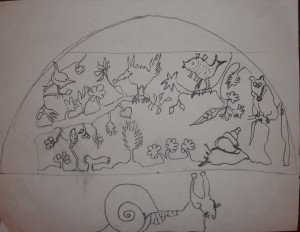
Gentle Jungle -1 , an early sketch
In fact, some of the important personalities of the jungle came into being in the later phase of work. For instance, the Henri Rousseau’s Tiger-face, contemplating a naked woman relaxing on a couch in his jungle, has been borrowed and made contemplating an equally naked Tigeress relaxing on a branch.
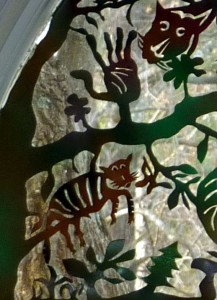

right: Henri Rousseau (Le Dounier)- The Dream, 1910 – fragments
Instead of a lily nearby, there is a palm with head, love and life lines to be read.
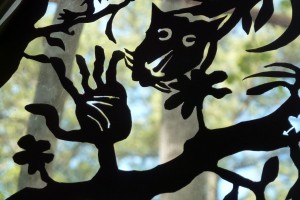

right: Henri Rousseau (Le Dounier)- The Dream, 1910 – fragments
Some additional inspiration came from an extremely powerful, incredibly original and not at least funny work of an incredibly early Dutch painter Hieronymus Bosch (1450?-1516). Bosch’s work makes me realize that a modern-way, we think, utmost witty, ironic and grotesque sense of humor is not a modern invention at all.

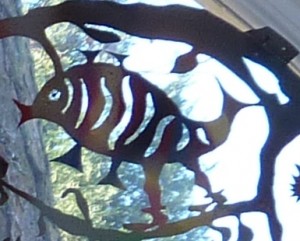
left: Hieronymus Bosch (1450?-1516), Last Judgment (fragment)
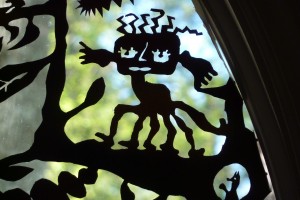
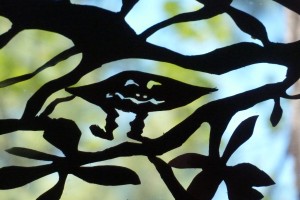
left: Hieronymus Bosch (1450?-1516), Last Judgment (fragments)
His Last Judgment and Garden of Earthly Delights are filled with creatures and monsters that are true delights for me. It is clear that this Bosch guy had an enormous fun with his creatures.
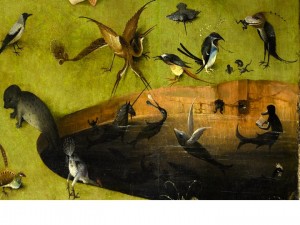
Bosch, Garden of Earthly Delights-triptych, left wing: Garden of Eden
The last pitch on this cutout that I would like to make is about snails that I felt are very pictogenic and placed them in the. Snails are fiercely and painfully underrepresented creatures in the visual arts. In fact, I could not remember any, zero, zilch, even one, example of a piece of art, which would feature those lovely animals. After extensive research I found a Dutch 17th century naturalist Otto Marseus van Schrieck (1614/1620–1678) painting from Uffizi, with one single snail.
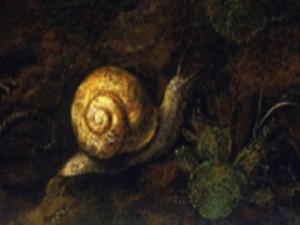
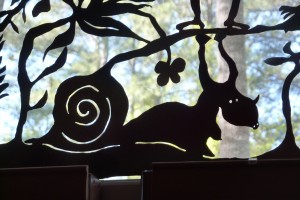
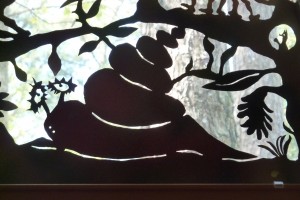
left: Otto Marseus van Schrieck, Underbrush with Reptiles and Butterflies
Out of the corporate pride I need to mention the cutout by Henri Matisse (1953) entitled “The snail” (below) that I recently saw (September 2014) at Tate Modern’s exhibition of Matisse’s Cutouts.

Henri Matisse, The Snail, paper cutout, 1953
Reactions of the snail community regarding that type of representation were not yet heard. There are some worries, though, that this cutout may be construed as a denigrating representation by more conservative members of the snail community. As a consolation to this community may be considered the fact that while Matisse have seen this work as his most abstract piece, he also acknowledged that the cutout was made “from life” (from the 2014 Tate Modern Exhibition catalog, p. 233).

Tomasz Hueckel’s metal cut-out artwork communicates to the viewer from a spirit of complete freedom of expression, even though several of his compositions have admitted roots in the paintings of other modern artists. In particular, these were inspired by his frequent visits to some of the most famous museums of Europe and the United States.
Even so, I would not necessarily characterize his art as modern, or even “wild” — but, obviously- contemporary and fresh. Despite the many “distortions of proportions” employed , the final composition of his major metal pieces are harmonious and pleasing to the eye. This is true for both his static forms as well as his mobiles. I find myself particularly fond of the latter, especially when strategically hung with proper illumination, or displayed in a window against a natural background- as at his house- of beautiful trees.
In short, these creations represent a truly unique style with innovative designs. Personally, I see them as near-perfect tranquilizers for stressful moments in our present ,stormy times.
I have been observing Tom’s creations for some years now, and have witnessed an incredible metamorphosis in his art, very much like that seen in some of his animal creations. At first glance, you may think a head belongs to a horse, but taking another view, it is rather a fish… I recall his experimental stage and have witnessed its evolution into a mature -if not playfully *) unique…- and innovative art form.
I proudly own one of his early creations. It is a mobile of a wild boar which hangs in my studio. It never fails to attract a comment or admiration from visitors.
xxxxx
[ Just as an aside, for anyone who knows the artist personally, his auto portrait (visible on his website) is a “masterpiece.” ]
*) knowing what a sophisticated wit …he is.
Marek Walicki